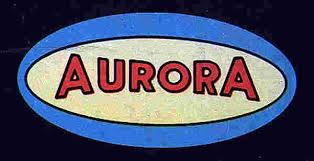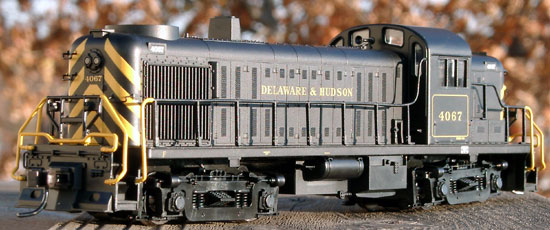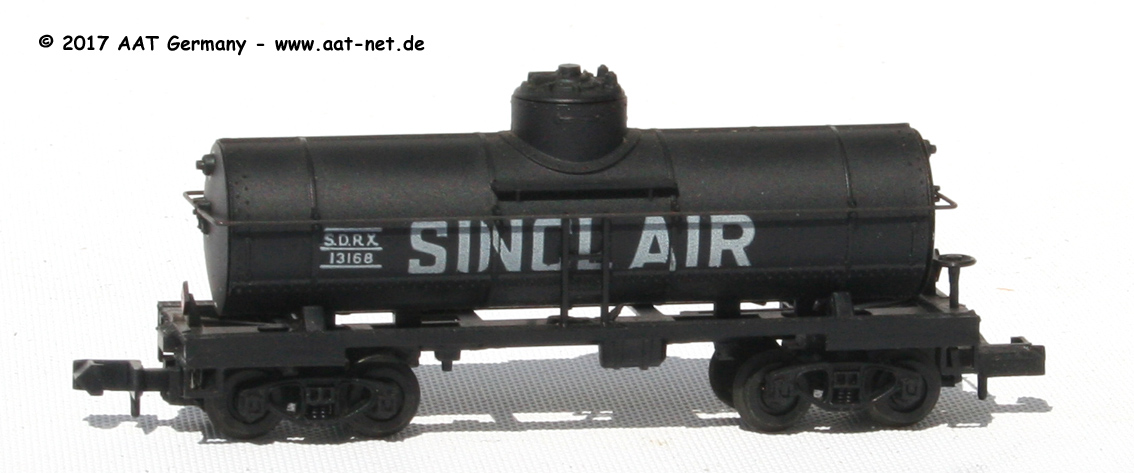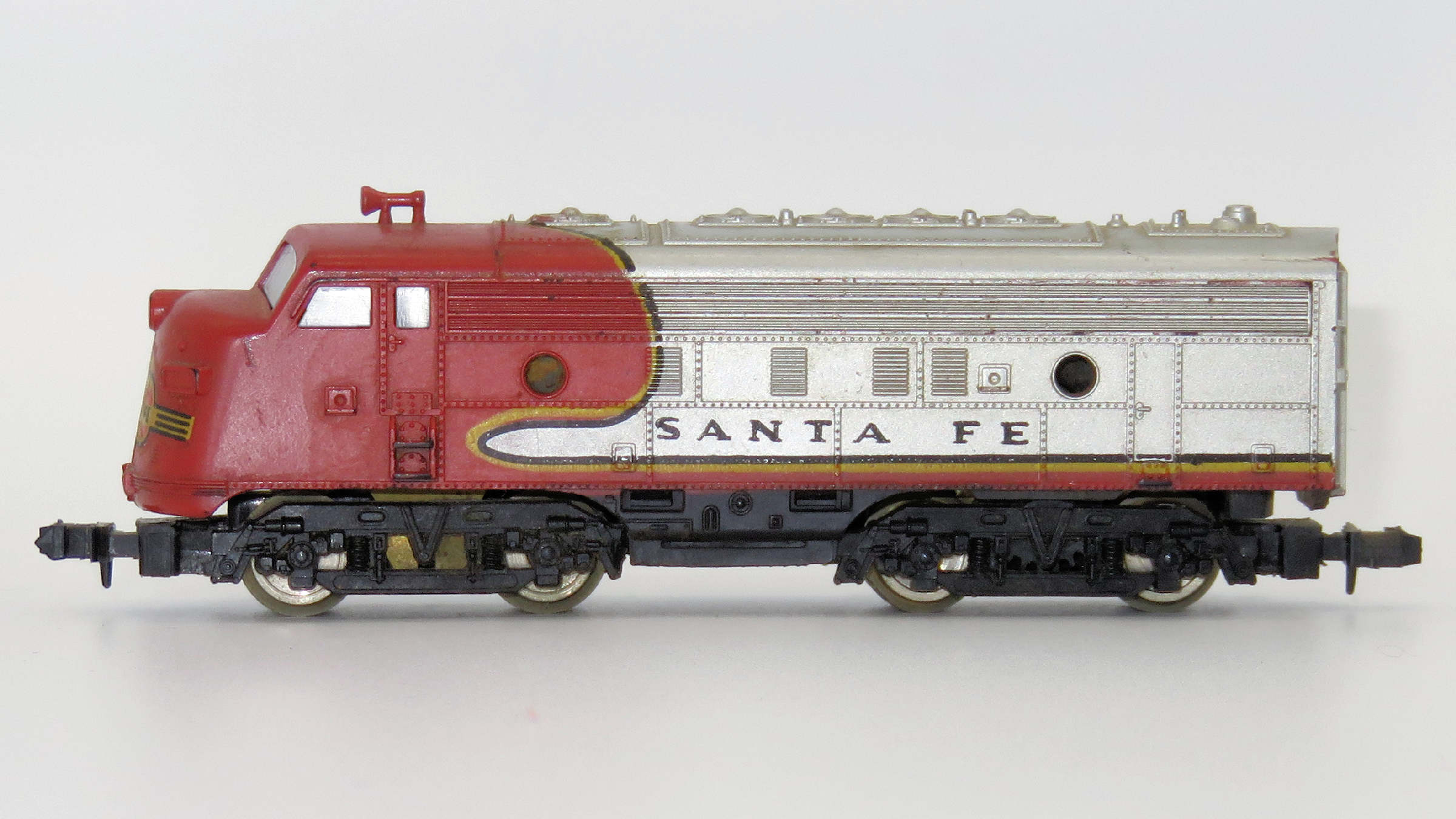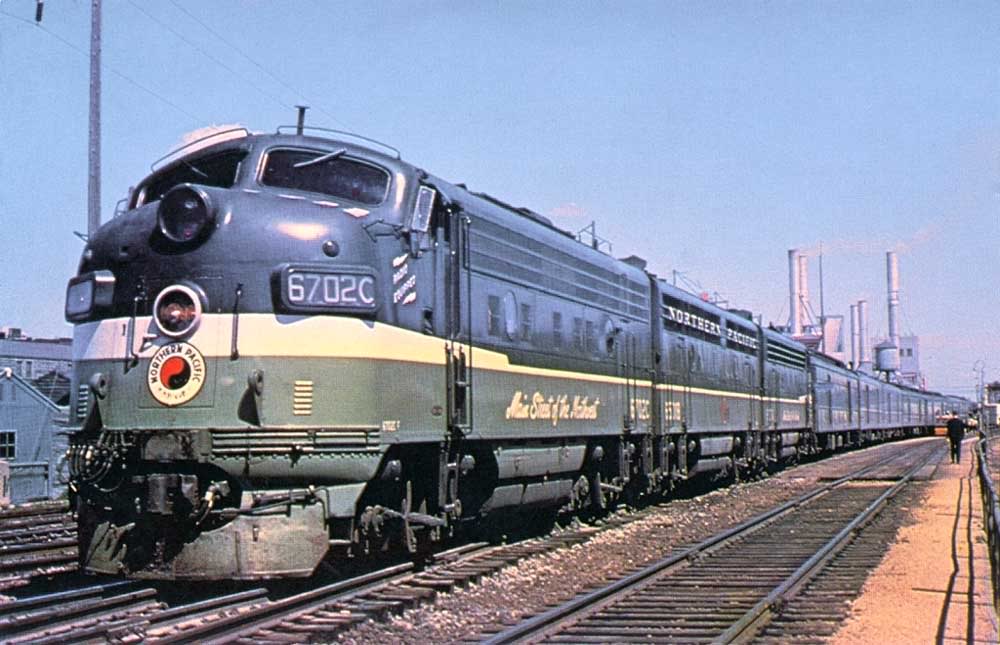Specific Item Information: Non-Powered Dummy A-Unit
Model Information: Introduced in 1966 as Aurora Postage Stamp models. Though Minitrix sold these as F9, the vent and porthole configuration suggest a F7.
Prototype History: The EMD F9 was a 1,750 horsepower (1,300 kW) Diesel-electric locomotive produced between February 1953 and May 1960 by the Electro-Motive Division of General Motors (EMD) and General Motors Diesel (GMD). It succeeded the F7 model in GM-EMD's F-unit sequence. Final assembly was at GM-EMD's La Grange, Illinois plant. The F9 was also built in Canada by General Motors Diesel at their London, Ontario plant. A total of 100 cab-equipped lead A units and 154 cabless booster B units were built. The F9 was the fifth model in GM-EMD's highly successful "F" series of cab unit diesel locomotives.
A F9 can be distinguished reliably from a late F7 only by the addition of an extra filter grille ahead of the front porthole on the side panels on A units. Internally, the use of an 567C prime mover increased power to 1,750 hp from the F7's 1,500 hp.
By the time cab units such as the F9 were built, railroads were turning to the road switcher-style of locomotive, and the F9 was succeeded in most part by the EMD GP9.
From Wikipedia
A F9 can be distinguished reliably from a late F7 only by the addition of an extra filter grille ahead of the front porthole on the side panels on A units. Internally, the use of an 567C prime mover increased power to 1,750 hp from the F7's 1,500 hp.
By the time cab units such as the F9 were built, railroads were turning to the road switcher-style of locomotive, and the F9 was succeeded in most part by the EMD GP9.
From Wikipedia
Road Name History: The Pennsylvania Railroad (reporting mark PRR) was an American Class I railroad, founded in 1846. Commonly referred to as the "Pennsy," the PRR was headquartered in Philadelphia, Pennsylvania.
The PRR was the largest railroad by traffic and revenue in the U.S. for the first half of the twentieth century. Over the years, it acquired, merged with or owned part of at least 800 other rail lines and companies. At the end of 1925, it operated 10,515 miles of rail line; in the 1920s, it carried nearly three times the traffic as other railroads of comparable length, such as the Union Pacific or Atchison, Topeka & Santa Fe railroads. Its only formidable rival was the New York Central (NYC), which carried around three-quarters of PRR's ton-miles.
At one time, the PRR was the largest publicly traded corporation in the world, with a budget larger than that of the U.S. government and a workforce of about 250,000 people. The corporation still holds the record for the longest continuous dividend history: it paid out annual dividends to shareholders for more than 100 years in a row.
In 1968, PRR merged with rival NYC to form the Penn Central Transportation Company, which filed for bankruptcy within two years. The viable parts were transferred in 1976 to Conrail, which was itself broken up in 1999, with 58 percent of the system going to the Norfolk Southern Railway (NS), including nearly all of the former PRR. Amtrak received the electrified segment east of Harrisburg.
The PRR was the largest railroad by traffic and revenue in the U.S. for the first half of the twentieth century. Over the years, it acquired, merged with or owned part of at least 800 other rail lines and companies. At the end of 1925, it operated 10,515 miles of rail line; in the 1920s, it carried nearly three times the traffic as other railroads of comparable length, such as the Union Pacific or Atchison, Topeka & Santa Fe railroads. Its only formidable rival was the New York Central (NYC), which carried around three-quarters of PRR's ton-miles.
At one time, the PRR was the largest publicly traded corporation in the world, with a budget larger than that of the U.S. government and a workforce of about 250,000 people. The corporation still holds the record for the longest continuous dividend history: it paid out annual dividends to shareholders for more than 100 years in a row.
In 1968, PRR merged with rival NYC to form the Penn Central Transportation Company, which filed for bankruptcy within two years. The viable parts were transferred in 1976 to Conrail, which was itself broken up in 1999, with 58 percent of the system going to the Norfolk Southern Railway (NS), including nearly all of the former PRR. Amtrak received the electrified segment east of Harrisburg.
Brand/Importer Information: In 1967, Aurora Plastics Corporation started importing the Minitrix N Scale product line. These trains were marketed as Postage Stamp Trains. It was a bold entry into what would become a very active market in the new N-Scale model train market. The basic starter set took advantage of N-Scale’s small size by packaging everything necessary for a small model railroad in a book-like box. The larger starter sets were packaged in more conventional boxes. Aurora went out of business in 1977.
The Body styles of this product line were made in Austria by Roco, imported into the United States by Minitrix and then rebranded by Aurora. Some of the exact same molds were also produced by Roco for Atlas who branded them using their own name.
A lot of information can be found on All about Aurora Postage Stamp Trains web site by David K. Smith.
The Body styles of this product line were made in Austria by Roco, imported into the United States by Minitrix and then rebranded by Aurora. Some of the exact same molds were also produced by Roco for Atlas who branded them using their own name.
A lot of information can be found on All about Aurora Postage Stamp Trains web site by David K. Smith.
Item created by: CNW400 on 2018-11-05 21:12:48
Last edited by: CNW400 on 2020-05-14 14:42:21
If you see errors or missing data in this entry, please feel free to log in and edit it. Anyone with a Gmail account can log in instantly.
Last edited by: CNW400 on 2020-05-14 14:42:21
If you see errors or missing data in this entry, please feel free to log in and edit it. Anyone with a Gmail account can log in instantly.



